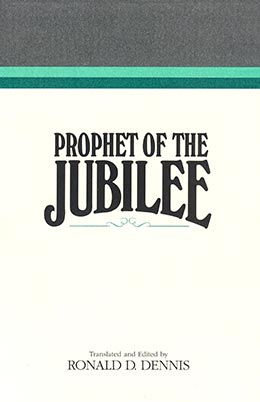Facsimile Translation Considerations
Ronald D. Dennis, ed., Prophet of the Jubilee (Provo, UT: Religious Studies Center, Brigham Young University, 1997), xxxiii–xxxvi.
1. Size. The size of the page and the print of the original has been enlarged by about thirty percent to facilitate reading.
2. Leading and point size. Whatever variations occur in space between lines and print size in the original are imitated in the translation.
3. Pagination. All major and minor headings are on the same page as the original, although the content of each page may vary by as much as four or five lines. No additional pagination to distinguish among the three volumes has been added; however, the part pages that precede each volume will distinguish between the years and ease the finding of specific items.
4. Paragraphs and sentences. The tendency of nineteenth-century writers was to use fewer paragraph breaks and much longer sentences than might seem appropriate today. However, for the sake of flavor the inordinate paragraph size and the seemingly interminable sentence length are imitated in the translation.
5. Brackets and parentheses. The only editorial comments in the translation are those of Dan Jones from the original; consequently, all brackets and parentheses are his.
6. Italicized words. Italics in the original are retained in the translation. Besides the normal practice of italicizing the names of periodicals, books, ships, etc., the editor used italics either to provide emphasis or to indicate the use of a borrowed word or phrase from English.
7. Punctuation. Some changes in punctuation and capitalization have been made to facilitate reading. Double quotations within double quotations are imitated, as are the occasional extra spaces around exclamation points and question marks.
8. Quotations. Even when placed between the appropriate marks, quoted material in Prophwyd often does not contain the exact wording used in the source. This is true also when the scriptures are quoted. This lack of precision is imitated, as is the method used for citing scriptural chapter and verse.
9. Typesetting errors. The typesetters of the original sometimes inverted letters, cited verses that did not match the accompanying scriptural quotation, left incomplete sentences, misspelled words, or committed other typesetting errors. Lacking an unobtrusive method of indicating such aspects of the original in the translation and fearing that confusion would result for today's reader if such flaws were duplicated, I decided to "correct" these kinds of imperfections in the translation. Considering the painstaking procedure required of nineteenth-century typesetters, the wonder is that more such miscues did not occur.
10. Typesetting oddities. Ending a page with only the first line of a new paragraph or with a hyphenated word is a frequent occurrence in the Welsh original. Also, the section headings are often near the end of a page. These practices are imitated in the translation.
11. Poetry. The primary focus in translating the poetry of Prophwyd y Jubili has been its content. However, D. L. Davies, Cwmaman, South Wales, has rendered poetic translations for several poems in the 1846 and 1847 issues.
12. Titles of foreign-language publications. To facilitate reading, I have used the English translations for all titles in the text and in the Annotated Contents. Tides in Welsh of all items published by Dan Jones are found in Welsh Mormon Writings. The following is a list of other publications mentioned in the Foreword and in the text and their corresponding titles in English and in Welsh:
The Apostolic Witness The Baptist Trumpet of Chartism The Chronicle The Congregational Treasury The Deceit of the Latter Saints Exposed The Educator The Essayist The Inquirer The Latter-day Saints and Miraculous Gifts The Latter Saints. Substance of a Sermon on the Miracles. The Oddfellow Hero The Patriot The Reviewer The Revivalist Star of the Saints Star of Gomer The Times The True Mirror Trumpet of Wales Welsh Magazine Zion's Trumpet | Y Tyst Apostolaidd Y Bedyddiwr Udgorn Chartiaeth Y Cronicl Y Drysorfa Gynnulleidfaol Twyll y Seintiau Diweddafyn Cael ei Ddynoethi Y Dysgedydd Y Traethodydd Yr Ymofynnydd Saint y Dyddiau Diweddafa Doniau Gwyrthiol Y Seintiau Diweddaf. Sylwedd Pregeth a Draddodwyd ar y Gwyrthiau. Y Gwron Odyddol Y Gwladgarwr Yr Adolygydd Y Diwygiwr Seren y Saint Seren Gomer Yr Amserau Y Drych Cywir Udgorn Cymru Cylchgrawn Cymraeg Udgorn Seion |
13. Place names. The modern spelling is used for all place names. The name in English is used for places that have both an English name and a Welsh name (e.g., Swansea for Abertawe, Cardiff for Caerdydd, and Blackwood for Coed-duon). Places mentioned in the text that are now known by a different name are Llwyni (now Maesteg), Newmarket (now Trelawnyd), and Penycae (now Ebbw Vale).
14. Proper names. I have corrected the spelling of Biblical and historical names; however, I have preserved the spelling used for all other proper names, even when the same individual's
name has two spellings (e.g., Harries and Harris, M. Comb and Macomb, Morgans and Morgan).
15. Annotated contents. Instead of inserting numbers and notes and detracting from the facsimile appearance of the translation, I have prepared an article-by-article commentary of the entire thirty issues. In many instances I give simply a brief statement of the article's contents, together with an indication of a source if the article is borrowed. I provide more detailed observations for those articles that contain historical information pertinent to the nineteenth-century movement of the Latter-day Saints in Wales.
